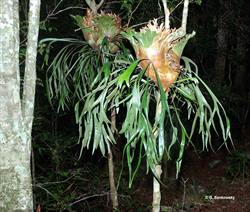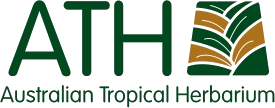Polypodiaceae
Australian Tropical Ferns and Lycophytes - Online edition
Platycerium bifurcatum



Platycerium bifurcatum (Cav.) C.Chr.
Link to Australian Plant Name Index for publication details and synonyms: https://id.biodiversity.org.au/name/apni/79413
Rhizome short-creeping, clothed with chaffy lanceolate scales, embedded in a nest of fronds and roots. Roots proliferous. Fronds dimorphic, sterile nest/base fronds laminating against host, rounded to reniform, 5–45 cm diam.; upper part spreading and nest-like, bluntly and deeply lobed, to 3 times forked, remaining green for a long time. Fertile foliage fronds ascending to pendulous, 22–105 cm long; base narrowly cuneate, 0–5 times forked; ultimate divisions strap-shaped, 0.5–3.2 cm wide; first fork usually at or below middle of frond, 1 division often remaining undivided following forking of the frond, the latter thus appearing to divide in threes; upper surface green, ±sparsely stellately hairy; lower surface greyish green, ±densely covered with stellate hairs. Sporangia covering most of the undersurface of ultimate segments of foliage fronds, sometimes reaching around sinus of first fork, sometimes not reaching apex. Spores 50–67.5 µm long, 25–35 µm wide.
Eastern QLD from near Cooktown to SE QLD and NSW.; also in Lord Howe Is.
Epiphytic or lithophytic in lower- to upper-montane vine forest. Most commonly seen as a large mass-forming canopy epiphyte in upland areas.
The nest fronds of this species are lobed on their upper margin and capture rain and falling debris and funnel it to the root system.
Readily cultivated on a tree, rock, slab or in a pot of coarse material. Grows well in a garden or fernhouse in the tropics, subtropics and warm temperate areas.
Key to Australian Platycerium spp.:
1a. Nests with a solitary growing point, fertile fronds with a single large sorus in the first sinus, nest-fronds forming a wide-spreading fan of lobes = Platycerium superbum
1b Nests forming a colony with several growing points, fertile fronds with sori on the penultimate lobes and not in the sinuses, nest fronds not forming a wide spreading fan of lobes = 2.
2a. Nest fronds with an entire upper margin and not forming a basket = Platycerium hillii
2b. Nest fronds with a lobed upper margin and forming a basket = 3
3a. Plants with a dense covering of stellate hairs, foliage fronds white below obscuring venation, nest fronds drying to a mushroom pink or grey, upper lobes narrow and finger like = Platycerium veitchii
3b. Plants with sparse covering of stellate hairs, veins vissible on lower surface of foliage fronds, nest fronds drying to a coppery brown, upper lobes not as above =Platycerium bifurcatum
Field AR, Quinn CJ, Zich FA (2022) Australian Tropical Ferns and Lycophytes. apps.lucidcentral.org/fern/text/intro/index.htm (accessed online INSERT DATE).
Field AR, Quinn CJ, Zich FA (2022) ‘Platycerium superbum’, in Australian Tropical Ferns and Lycophytes. apps.lucidcentral.org/fern/text/entities/platycerium_superbum.htm (accessed online INSERT DATE).







